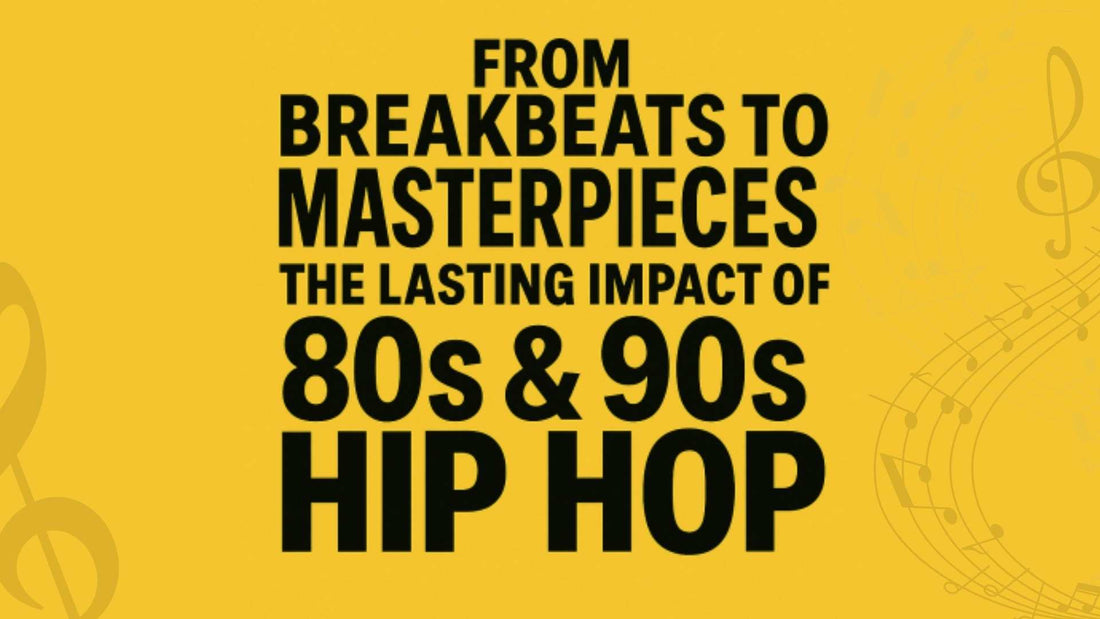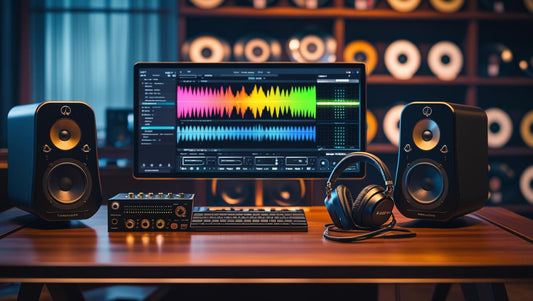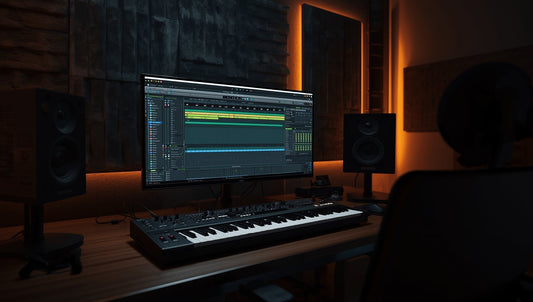From Breakbeats to Masterpieces: The Lasting Impact of 80s & 90s Hip Hop

From Breakbeats to Masterpieces: The Lasting Impact of 80s & 90s Hip Hop
Step into a time machine and journey back to the Golden Age of Rap, where the rhythmic pulse of the 80s and 90s Hip Hop not only revolutionized music but reshaped culture itself. This era, marked by innovative rap producers who wielded samplers like magic wands, transformed breakbeats into masterpieces and set the stage for lyrical mastery that remains unparalleled. Hip-hop history was made as MCs used their verses to address pressing social issues, turning their art into a
powerful protest against systemic injustices. As regional rap scenes flourished across the nation, from the gritty streets of New York and Los Angeles, the cultural impact of hip-hop echoed far and wide, igniting a creative explosion that birthed classic rap albums still revered today. Join us as we explore the vibrant tapestry of this Golden Era, where community competition fueled a relentless drive for authenticity and creativity.
Innovation in Sound
The Golden Age of Rap was a sonic revolution. Innovative rap producers pushed the boundaries of music creation, experimenting with sampling techniques that would define the era. Armed with groundbreaking tools like the SP-1200 and MPC60, these sonic architects layered breakbeats with elements from funk, jazz, rock, and soul to create rich, textured soundscapes with a very DIY-infused mindset.
Pioneers like Marley Marl, The Bomb Squad, Dr. Dre, and DJ Premier became the alchemists of hip-hop, transforming disparate musical elements into gold. Their innovative approach to beat-making not only set the standard for hip-hop production but also influenced music production across genres. This era of experimentation laid the foundation for the diverse and dynamic sound of hip-hop we know today.
Sampling and Breakbeats Revolution
The sampling and breakbeats revolution fundamentally changed the way music was created and consumed. Producers began mining vast libraries of existing recordings, extracting short segments of rhythm or melody to create entirely new compositions.
This technique allowed for the fusion of diverse musical genres, creating a rich tapestry of sound that became the backbone of hip-hop. Breakbeats, isolated drum segments from funk and soul records, became the rhythmic foundation for countless rap tracks.
The art of sampling not only revolutionized hip-hop but also challenged traditional notions of musical ownership and creativity. It sparked legal debates and eventually led to changes in copyright law, forever altering the music industry landscape.

Evolution of Music Production
The evolution of music production during this era was marked by rapid technological advancements. The introduction of affordable sampling keyboards and drum machines democratized music production, allowing aspiring producers to create professional-sounding tracks from their bedrooms.
This period saw the transition from analog to digital recording techniques, offering producers unprecedented control over the minutiae of their sound. The ability to manipulate individual elements of a track with precision opened up new creative possibilities.
As production techniques evolved, so did the role of the producer in hip-hop. Many producers became artists in their own right, with their sonic signatures becoming as recognizable and sought-after as those of rappers themselves.
Lyrical Mastery
The Art of Rhyme
The Golden Age of Rap saw an unprecedented focus on lyrical prowess. MCs elevated their craft, prioritizing complex wordplay, intricate metaphors, and potent social commentary. This period witnessed a explosion of diverse styles, from the vivid storytelling of Slick Rick, to the lyrical dexterity of Big Daddy Kane, and the game-changing prowess of Rakim, hip-hop was laying the foundation for generations to come.
Lyrical mastery became the benchmark of an MC's worth. Artists were judged on their originality, intricate rhyme schemes, and distinctive delivery. This emphasis on verbal dexterity pushed rappers to new heights of creativity, resulting in a golden era of lyricism that continues to inspire and challenge artists today. The complex bars and clever wordplay from this period set a high standard that many argue has yet to be surpassed.
Cultural and Political Relevance
Voice of the Streets
During the Golden Era, hip-hop transcended mere entertainment to become a powerful vehicle for social and political commentary. Artists used their platforms to tackle pressing issues like poverty, racism, police brutality, and the struggles of life in neglected urban communities. Groups like Public Enemy, N.W.A., Geto Boys, and KRS-One transformed rap into a voice for the unheard, their lyrics serving as both protest and education.
This era saw hip-hop history being made as the genre evolved into a cultural force that could no longer be ignored. The music became a source of pride and empowerment for marginalized communities, offering a raw, unfiltered perspective on urban life that was often absent from mainstream media. The cultural impact of hip-hop during this period extended far beyond music, influencing fashion, language, and attitudes across the globe.
Rap emerged as a voice for marginalized communities, offering raw, unfiltered perspectives on life in America's inner cities. Songs like Grandmaster Flash and the Furious Five's "The Message" laid the groundwork for socially conscious hip hop.
The impact of this lyrical activism extended beyond music, influencing public discourse and inspiring a new generation of activists. It demonstrated hip-hop's potential as a tool for social change and solidified its place as a significant cultural force.
Regional Explosions
The Golden Age of Rap saw hip-hop evolve from a localized New York phenomenon into a national movement. The East Coast, particularly New York City, remained a powerhouse, producing legends like Nas, Wu-Tang Clan, and A Tribe Called Quest. Their intricate lyricism and jazz-influenced beats defined the East Coast sound.
Meanwhile, the West Coast exploded onto the scene with Too Short, N.W.A., Ice Cube, DJ Quik, and Dr. Dre introducing the world to G-Funk and gangsta rap. The South began planting seeds of its own unique style with artists like UGK, Outkast, and Three 6 Mafia, foreshadowing the region's future dominance. As indie powerhouses No Limit and Cash Money began their respective rise to dominance
in New Orleans, this diversification of regional rap scenes enriched the hip-hop landscape, each area contributing its distinct flavor to the genre's evolution.
Sonic Time Capsules
The Golden Era of hip-hop was marked by the release of numerous classic rap albums that continue to influence artists today. These weren't just collections of singles, but cohesive artistic statements that pushed the boundaries of what a rap album could be. Masterpieces like "Paid in Full," "It Takes a Nation of Millions to Hold Us Back," "The Chronic," "Illmatic," "Ready to Die," "Enter the Wu-Tang (36 Chambers)," and "The Diary,"set new standards for the genre.
These albums were sonic time capsules, capturing the energy, creativity, and social climate of their time. They showcased not only lyrical prowess but also innovative production techniques that would shape the sound of hip-hop for years to come. The cultural impact of these classic rap albums extended far beyond the music world, influencing fashion, slang, and attitudes across the globe.
Hip Hop Crews and Radio
The Golden Age of Rap thrived on a spirit of community and competition that pushed artists to new heights of creativity. Crews and collectives like the Juice Crew, Native Tongues, and Wu-Tang Clan fostered collaboration and friendly rivalry, driving innovation in both lyrics and production. This era saw the rise of battle culture, where MCs honed their skills through fierce lyrical showdowns.
Radio shows like Stretch and Bobbito and Sway and Tech, as well as the abundance of now famous and still sought-after mixtapes, played a crucial role in this ecosystem, breaking new artists and showcasing raw talent through freestyles and exclusive tracks. This vibrant, competitive environment ensured a constant flow of fresh ideas and styles, keeping the genre dynamic and ever evolving. The legacy of this rap community competition continues to influence hip-hop culture today, maintaining the genre's spirit of innovation and authenticity.
Impactful MCs of the 80s and 90s
The 80s and 90s saw the rise of numerous impactful MCs whose influence continues to resonate in hip-hop culture today. Artists like Tupac Shakur, The Notorious B.I.G., Outkast (Andre 3000 & Big Boi) not only achieved commercial success but also left indelible marks on the art form.
These MCs were distinguished by their unique styles, personas, and lyrical approaches. Tupac's passionate delivery, poetic sensibility, and overall intensity contrasted with Biggie's smooth flow and vivid storytelling, while Andre 3000 was reminding listeners that "the South's got something to say" with verbal dexterity rivaling anyone in hip-hop.
The legacy of these artists extends far beyond their music. They became cultural icons, influencing fashion, language, and attitudes well beyond the realm of hip hop. Their impact on popular culture underscores the transformative power of rap during this golden era.
Cultural and Regional Impact
The Golden Age of Rap saw hip-hop transcend its origins as a localized subculture to become a global phenomenon. This expansion was characterized by the emergence of distinct regional scenes and a growing influence on mainstream culture.

The cultural impact of hip-hop during the Golden Age was profound and far reaching. Hip-hop's influence extended beyond music, shaping fashion, language, visual art, and even political discourse.
In fashion, the styles popularized by rap artists - from Run-DMC's Adidas sneakers to the streetwear (Phat Farm, FUBU, Pelle Pelle, Rocawear, Sean John, and many others) of the 90s - became global trends. Hip-hop slang entered the mainstream lexicon, with terms originating in rap lyrics becoming part of everyday speech.
The visual aesthetics of hip-hop, from graffiti art to music video imagery, influenced graphic design, advertising, and fine art. This period saw hip-hop culture begin to shape academic discourse, with scholars recognizing its significance as a form of cultural expression and social commentary.
Rap Community and Competition
The rap community during the Golden Age was characterized by a spirit of both collaboration and competition. This dynamic fueled creativity and pushed artists to continually innovate and improve their craft. Nowhere was this more present than at The Good Life Cafe and Project Blowed, two LA staples showcasing the City of Angels's support and fostering of local artists.
Rap battles, both formal and informal, were a crucial part of hip-hop culture. These lyrical showdowns served as proving grounds for up-and-coming MCs and helped establish reputations within the community.
Collaborations between artists, often across regional lines, led to some of the era's most memorable tracks. These partnerships fostered a sense of community while also allowing for the cross-pollination of styles and ideas.
The competitive spirit of this era drove rapid evolution in both lyricism and production techniques. It created an environment where innovation was not just encouraged but necessary for survival in the fast-paced world of hip-hop.
No comments








0 comments